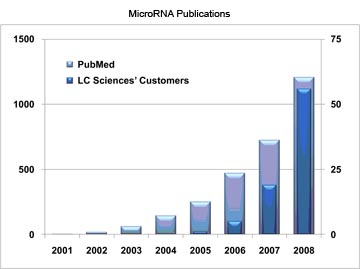Taking full advantage of its flexible µParaflo® Biochip Technology, Houston based LC Sciences today announced immediate availability of probe content from the newly created Plant MicroRNA Database (PMRD) for their microRNA (miRNA) microarray customers . This announcement comes immediately following a publication in Nucleic Acids Researchintroducing the public database 1 . The PMRD integrates available plant miRNA data deposited in other public databases, gleaned from the recent literature, and data generated by the database organizers. It is freely available at http://bioinformatics.cau.edu.cn/PMRD.
LC Sciences miRNA microarrays make use of a microfluidics on-chip synthesis platform, termed µParaflo®, versus a traditional spotted array based on pre-synthesized oligonucleotides. This on-chip synthesis platform means made-to-order microarrays can be produced, delivering the most up-to-date research tools to researchers; in this case, the PMRD content.
In total, there are 8433 miRNAs collected from 121 plant species in PMRD, including model plants and major crops such as Arabidopsis, rice, wheat, soybean, maize, sorghum, barley, etc. For Arabidopsis, rice, poplar, soybean, cotton, medicago and maize, the possible target genes for each miRNA with a predicted interaction site are included in the database. This represents a significant increase in content vs plant miRNA microarrays based solely on the miRBase content.

The public miRBase sequence database 2 serves as the primary probe content for many commercially available miRNA profiling microarrays (http://microrna.sanger.ac.uk/sequences/). Detection of miRNAs using a microarray offers the opportunity for genome-wide miRNA expression profiling by examining all known miRNA transcripts in a single experiment. However, in a rapidly evolving field such as miRNA research, it is important to have a flexible system that can keep up with all the newly discovered and predicted sequences. Pre-spotted glass slide arrays immediately go out of date whenever new miRNA database versions are released. LC Sciences’ microarrays ensure scientists have the most complete picture of miRNAs expressed in their experimental samples.
Via EPR Network
More Biotech press releases

